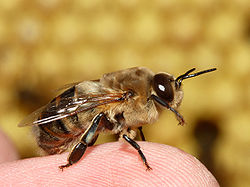The Male Of The Honey Bee Colony: The Drone
It comes as no surprise to beekeepers that most people, get a kick out of the fact that the hive is mainly female. This comes from the fact that 10 to 20 percent of the hive is male. The drone is easily spotted by their large eyes, medium size body and long legs.
A drone is the result of an unfertilized egg. Normally, a Queen bee will deposit the unfertilized egg in a drone cell. A drone cell, compared to a worker cell, is slightly larger. Unlike the worker bee, the drone will take 24 days from egg to Adult.
When the egg is laid it will take three days for the larva to hatch. On the 11th day the larva is mature enough to be(e) capped. This capped cell is easily noticed since the cell is dome shaped.
Drones do most of their flying in the afternoon. Their search in the afternoon is mainly to find a unfertilized queen bee to mate with. Interestingly enough, the drone will mate with the queen bee in midair and once he mates with the chosen queen he dies. But he has completed the task that nature has given him.
Other than mating, Drones do not have any other specific task. They do not defend the hive since they do not have a stinger. For this reason they are easily picked up by a beekeeper with their bare hand! Additionally, the drone has a tiny proboscis, "tongue", and is not able to feed themselves. Thus, the worker bees must feed them.
Later in the fall, the queen will lay fewer drones since mating season is over. As winter approaches, the worker bees will begin to drive the drones out of the hive. This phenomenon is the result of the hive no longer needing the drones for the winter and to conserve as much resources as possible.
Thus the life of a Drone is over. Nevertheless, their numbers will reappear as mating season begins.



.JPG)












